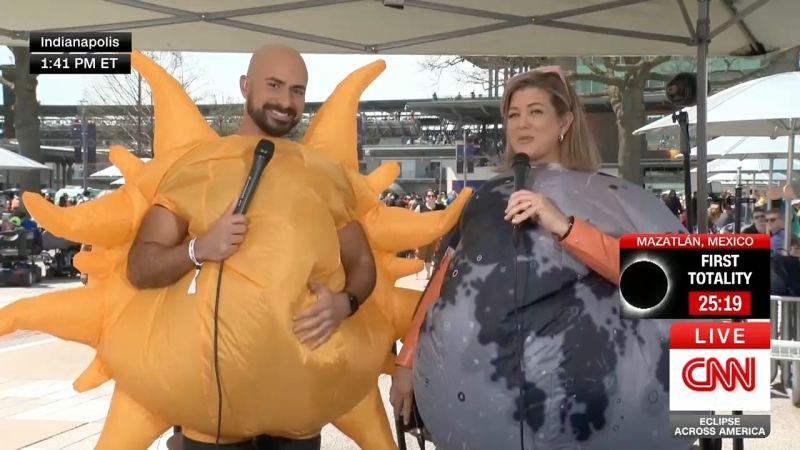Editor’s Note: A version of this article first appeared in the “Reliable Sources” newsletter. Sign up for the daily digest chronicling the evolving media landscape here.
Millions of viewers on Monday tuned into special news broadcasts to watch the once-in-a-generation total solar eclipse as it cast a shadow across North America. National news networks deployed anchors and crews along the path of totality from Mazatlán, Mexico, to Indianapolis to Vermont, capturing the awe-inspiring and quasi-religious experience millions felt with live cameras.
But while the pros behind the scenes might have made the coverage look easy, putting on a seamless broadcast was not without challenges.
We spoke with the leaders of CNN’s celestial coverage, who offered insights into how the network deployed teams and resources to track the eclipse as it swept across the US. Below is a Q&A, lightly edited for length and clarity.
How many people were involved in covering this celestial event?
Lyndsey Read, senior producer for content strategy: Experts from across the company representing all of our platforms jumped in to create and optimize our content for audiences everywhere including producers, shooters, writers, reporters, editors, anchors, programmers, art designers, podcast producers, photographers, researchers and many more. It was a true collaboration.
What was the biggest challenge in organizing coverage around the eclipse?
Vivian Kuo, senior director of coverage for national newsgathering: We wanted to make sure we were touching on narratives within the path of totality that would offer unique perspectives. From the majesty of Niagara Falls, to a mass wedding in Arkansas with more than 300 couples, to hanging with giraffes – we wanted each location to give viewers special perspectives in case they couldn’t be there in person.
Did you have to make any last minute adjustments due to the changing forecasts? How down to the wire were those changes made?
Kuo: We did have a robust plan to be in Texas up until near the end of last week, but with the cloud cover forecast being a little too ominous for comfort, we audibled to the biggest watch party in the Midwest, in Indianapolis. The field teams did a heroic job of being nimble and scrambling despite the last-minute changes.
How does this compare to planning coverage around a severe weather event or a political event like a debate?
Kuo: Very similar – except since this is really such a feel-good story we had a lot of staff reaching out from all over the network asking to play! It was nice to do something that was fun and such a collective cultural moment.
Read: Compared to other big news events on our calendar, it’s so refreshing to build a plan around a positive news story — especially one that impacts so many people across North America. From kids and adults of all ages, to scientists, zookeepers, eclipse-chasers — it’s been fascinating and delighting to get swept up in the excitement around this.
What lessons did you learn from the 2017 eclipse that helped this time around?
Read: 2017 seems like such a long time ago. When we reviewed the 2017 coverage and insights, we were reminded that the audience has an incredible appetite for such a visceral and visual story. And CNN is one of the few outlets that really has the resources to own this. Next up – 2044 eclipse!
In what ways did CNN aim to educate its audience about the science and significance of a total eclipse?
Read: CNN published one of the first eclipse stories nearly a year ago so this is about so much more than one day of coverage. There has been a steady drumbeat – led by our Science and Video teams – of informative, entertaining and educational features, interactive products, newsletters and much more. Our daily news show for students, CNN10, dedicated an entire episode to the eclipse.
During live coverage, what was one element that took you off guard or surprised you?
Kuo: It’s fair to say Brianna Keilar and Boris Sanchez in their sun and moon getup was simultaneously surprising and amazing. I also loved Ed Lavandera feeding the giraffe and the ostrich egg laying moment. And of course, you can’t forget Kristin Fisher’s incredible interaction with her astronaut parents and unbelievably precocious daughter.
Read: I was bouncing between several different video offerings and the live story, and I was surprised to get caught up in the suspense of it all! Thankfully I also had a pair of eclipse glasses so I could join in the fun.
In your opinion, which CNN personality looked best rocking the solar shades?
Kuo: That’s so hard. Rosa Flores owned the whimsical ones, Brianna’s pink ones were probably the most stylish – but I might give it to Derek Van Dam, whose aviator-goggle style looked all too comfortable on him.
Read the full article here
